Here is a lightly edited text of the long (20-minute) paper that Jennifer Guiliano and I co-authored and delivered at the Digital Humanities 2014 conference in Lausanne, Switzerland. As we noted at the time, this talk is extracted from a larger work in progress in which we are trying to get to grips with what seem to be persistent challenges in organizing the work of digital humanities research.
Since we were fortunate to receive so many excellent comments and questions from the audience who could attend in Lausanne, we wanted to offer the text here as a way of facilitating continuation of the conversation. We warmly welcome further comments, challenges, questions, corrections and disagreements.
Finally, some of the comments on Twitter made clear that we could have signposted more clearly that many of the issues we take up here might be particular to the context of U.S. universities and less relevant to different institutional or international contexts.…
Cross-posted at jguiliano.com
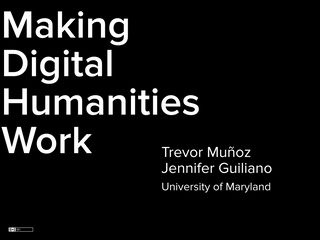
This paper, officially titled “Making Digital Humanities Work”, is on its face about an activity we created to engage librarians at the University of Maryland in digital humanities. This activity, which we called the "Digital Humanities Incubator" might look outwardly like a training program but that label will be slightly misleading for the purposes of this discussion. We’ll reveal what the incubator encompassed and how it worked and didn’t work.
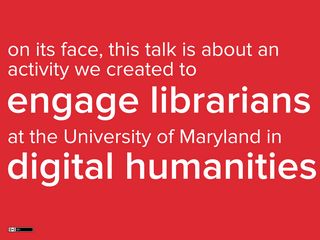
Yet this “resume” of the activity—what is usually considered the meat of the presentation is provided here merely as background to an attempt to grapple with larger problems that arise in any effort to organize DH work.
Through discussing our experience with planning the incubator and then creating and running a first iteration of the activity, we hope to do four things: first, to argue for the continuing urgent need to reflectively critique the structure and practice of labor in the (digital) humanities; second, to suggest that there are valuable insights to be gained by taking a “deflationary” approach as part of this critical examination; third, to contribute a few insights (we hope) from our local situation; and finally, fourth, to encourage future work along these lines of theoretical engagement. Thus in this presentation, our treatment of the digital humanities incubator is both a reflective and prospective endeavor.
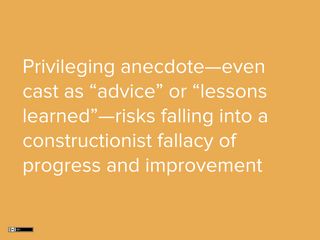
For us, the activity of trying to figure out how to bring new participants into the digital humanities has functioned as an exercise in critical design—we have used the making and re-making of this activity as a space for thinking through alternate ways to make the digital humanities work—ultimately culminating in the Digital Humanities Incubator. We hope it will be clear over the course of the talk that the primary change we were trying to effect was not really skill acquisition—thus, why labeling the Incubator a training initiative is slightly misleading. The primary change we hoped for had more to do with empowering librarians to see their position differently with regard to digital humanities research.
While much has been said and written about securing more resources and recruiting and developing talented labor, this approach runs the risk of slipping into individual anecdote—isn’t each institutional situation unique?—when what is needed is structural critique of the larger system within which DH work exists. Privileging anecdote—even cast as “advice” or “lessons learned”—risks falling into a constructionist fallacy of progress and improvement—more digital humanists, more money for digital humanities centers/labs/initiatives will lead to the Transformation (capital “T) of the humanities and the academy. More simply, ignoring the system in favor of the individual fails our humanistic tradition of critical analysis and theoretical engagement.
Bringing the theoretical concerns of our disciplines (history and library and information science, in this case) to the daily practice of our digital humanities work, our initial goal with the structure and curriculum of the incubator was to attempt to more accurately communicate how digital humanities project work takes place rather than to retread pre-existing patterns of digital humanities research.
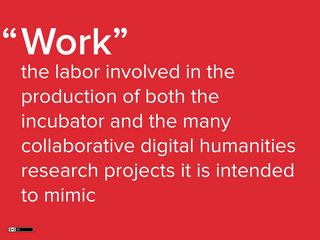
The doubled meaning of our title reflects this tension. 'Work' here means the labor involved in the production of both the incubator and the many collaborative digital humanities research projects it is intended to mimic.
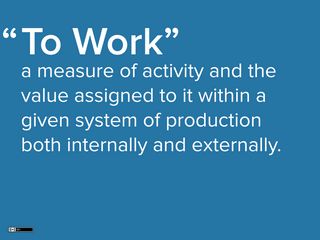
It also has the sense of 'to work'—a measure of activity and the value assigned to it within a given system of production both internally and externally.
Background
We begin our presentation with where we ended—the structure and content of our first iteration of the Digital Humanities Incubator and then we will move backwards to unfold the motivations and decisions that led us to this conscious intervention around digital humanities work.
Participants in the Digital Humanities Incubator were librarians from the University of Maryland during the 2013-2014 year. The Incubator targeted academic librarians of all ranks, library staff, and graduate assistants who wished to gain new capabilities for developing, supporting, and leading digital projects. The Incubator activity was part of a conscious effort by library leadership to correct a lack of institutional support, and engagement with, digital humanities research by librarians. Over the course of the Incubator, forty-two librarians, staff, and graduate students participated in at least one workshops and exercise set. A significant portion of this number participated in all the activities.
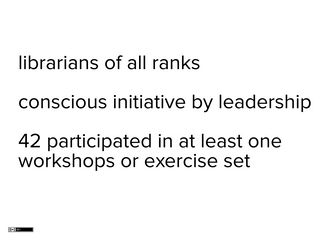
Workshop and exercise topics covered the process of developing digital humanities project ideas, finding data, evaluating tools, and crafting a compelling proposal for internal or external funding.
Our first workshop focused on providing attendees with a sense of contemporary definitions of DH, an overview of the scope and variety of DH approaches, and perspective on this sprawling landscape such that, by the close of the session, participants could articulate some ideas of how DH might be connected or applied to their own librarianship, research, or service.
Workshop two focused on the mechanisms of developing DH research ideas. Participants were encouraged to approach their own existing library work as material that could be framed as research ideas. This workshop also discussed strategies to determine the value of these research ideas as potential interventions in the ongoing discourses of digital humanities. Our goal was that by the close of the second workshop, participants could communicate at least one idea of something from their regular practice of librarianship as a research idea.
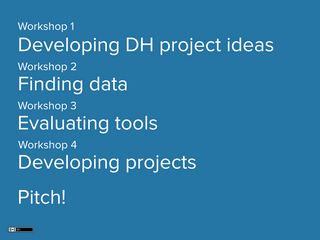
Workshop three focused on preparing and working with data—the basis of many digital humanities research projects. Participants were given a series of tutorials that allowed them to hunt and gather data, sort and improve it via common data tools, like Open Refine, and transform it for analytical and display use. The goal of the workshop was for each participant to gain experience in identifying data that might pertain to their own research interests and to explore the different ways common digital tools might analyse and visualize that data.
Workshop four aided participants in developing the research idea they’d been working with throughout the sequence into an externally-communicated project proposal. Participants were provided with an overview of the key components of project proposals (goals, workplan, staffing, budget, etc) and worked to elucidate those individually (or collectively where needed). The goal of this workshop was less a fully formulated project proposal than the identification by participants of the resources and partnerships they might need to bring their research idea to fruition.
Skills learned in this program were grounded in participants’ own project ideas and interests, supported by the brief in-depth lectures described above. This approach was intentional as we sought participants to focus on their roles as authors and leaders of the academic research mission of the university—marrying information organization and curation with scholarship and public engagement through the use of digital technologies.
The Incubator was implemented using in-kind support from MITH in the form of staff time—each of us wrote the lectures, led office hours, and staffed the individual consultations leading up to the close of the workshop cycle with one other MITH staff member contributing a limited amount of instructional support for the data workshop.
Low availability of resources (translated mechanistically into small staff commitment) meant that we were able to be flexible and agile in adapting the program to the needs of librarians. For example, we needed to schedule events with librarians differently than we might with other faculty participants due to different expectations of work schedules. Each workshop needed to be held twice—once in the morning and once in the afternoon on alternate days, spaced at least two days apart. This allowed part-time librarians, library division heads, and full-time reference/subject librarians to have the opportunity to attend without having to make special work arrangements. This also allowed for librarians to potentially hear the same workshop content twice—an allowance useful for differing types of learning styles. Librarians were able to attend the first workshop, listening and taking notes, then return for the second to ask questions and further understand what they might have missed the first time. This was particularly important for the “data” workshop where participants were encouraged to scrape, manipulate, and explore data in ways unfamiliar to many librarians but crucial to much digital humanities work.
Additionally, by interlacing office hours with each workshop, the co-instructors were able to revise content, post answers to questions, and facilitate immediate interventions on the project level where needed. In part, this blended structure combining instruction with hands-on work with participants’ own project ideas allowed for quick implementation, demonstration of core concepts, discussion and reflection. It also gave participants a sense of a dedicated individual with whom they could develop a personal relationship. This relationship-building was crucial to alleviate feelings of anxiety and to counteract assumptions that particular topics or projects were not "research" or not "digital humanities" enough. Simply, building up familiarity between librarians and instructors helped librarians feel welcome in the space of the digital humanities. Further, librarians attending without their own project were encouraged to join a colleague’s. This “learn and do” philosophy enabled collaboration across divisions in rewarding ways that we do not, unfortunately, have time to explore here.
Incubator participants were encouraged but not required to "pitch" an idea for a digital project during the capstone event for the Incubator program. These short (5-minute) presentations drew on skills acquired during the Incubator, forcing participants to frame their research interests in terms of potential audiences, available technologies, and overall feasibility of timeframes and budgets. Thirteen librarians or teams of librarians participated in the "pitch round" during the capstone event. These presentations were attended and evaluated by an audience of their peers from the Libraries as well as by MITH staff. Five finalists were chosen to continue refining their proposals for a potential longer term joint project. Putting potential project ideas in front of an audience both reflected back to the community at large the dynamism and diversity of research ideas coming from librarians but also assured potential project leaders of an engaged and supportive audience for work of this kind. [Ed.: Prompted by an excellent question from the audience, we clarified that this project pitch was not meant to encourage participants to “package” or close off their ideas for an external requirement. Rather we attempted to use the discipline of the proposal to help participants focus on distilling and communicating their ideas to a public audience. We also acknowledged that this way of wrapping up the Incubator sequence is a vestigial gesture that falls back in some of the habits we were trying to distance the new activity from.]
"Unsuccessful" proposals also generated new digital initiatives for the Libraries by being turned back to divisions that could assist in their development. These spin-off projects—one related to crowdsourcing and one related to acquisition of basic programming skills—found homes as internal library projects. These conjoined activities—workshop, office hours, consultation, and pitch—encapsulated the "work" of the Digital Humanities Incubator. To be clear, our intention is not to present the Incubator as an unqualified success. While very successful internally to the University of Maryland Libraries and MITH in terms of generating enthusiasm and contributing to a broader positive change in tenor of conversations around research, digital technologies, and collaboration across the institution, the activity has been difficult to sustain for a variety of reasons.
Need for Critique
The design of the activity that we’ve just described was an attempt to respond to shortcomings within the model of collaborative practice we had received and participated in as working digital humanists. Fellowships for faculty to conduct digital humanities research in partnership with librarians, technologists, or other university staff have been a common way of organizing DH work. Although faculty fellowships have been mothballed at many established digital humanities centers (e.g. the Center for Digital Research in the Humanities (CDRH) at the University of Nebraska, MATRIX at Michigan State, ICHASS at Illinois), many programs, centers, and initiatives continue to offer these opportunities as their main form of faculty engagement. The 5 College Program, the Tri-County Digital Humanities Program, the Institute for Digital Arts and Humanities at Indiana, as well as the much more established Institutes of Advanced Technology at UVA and MITH at Maryland provide these as a key component of digital humanities work on their campuses.
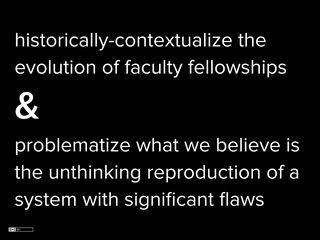
Identifying that faculty fellowship is often a first form of digital humanities work when establishing new programs and initiatives, we seek here to historically-contextualize the evolution of faculty fellowships and problematize what we believe is the unthinking reproduction of a system with significant flaws. At MITH, while faculty fellowship opportunities have ostensibly been open to faculty from the College of Arts and Humanities and librarians, in practice, recipients have been overwhelmingly tenured or tenure-track faculty from the College of Arts and Humanities. How did MITH arrive at the point of only supporting this very narrow slice of digital humanities work?
In part, one cause of this limitation can be found at the root of the model MITH adopted and adapted from the Institute for Advanced Technology in the Humanities (IATH) at the University of Virginia. When MITH initiated its fellowship program in 1999/2000, IATH was considered a leader in digital humanities. Its faculty fellows program had produced some of the most innovative digital projects of the time (Valley of the Shadow, The Rosetti Archive, The William Blake Archive, etc.) Drawn from humanities faculty, IATH fellows were selected through a competitive application process with the winners receiving two parallel packages. From their home departments, they were granted half-time teaching release as well as ten hours a week of student assistance during the academic year. From IATH, they received an additional ten hours of graduate assistance per week, a $10,000 project budget (1992 dollars), office space and equipment, programming, information systems design, and consulting for the life of the project. Adjusted for inflation and using an averaged cost for graduate student labor, faculty fellows were thus granted a one-time investment of roughly $50,000 plus additional support in personnel costs for programming, information systems, and consulting. John Unsworth, former director of IATH, estimates that over the course of a single fellowship, faculty fellows received “hundreds of thousands of dollars of support.” More significantly, though, IATH fellows were part of a much broader system of digital humanities work that drew upon expertise at the E-Text Center, the UVA Libraries, and other campus based resources. Library staff were embedded within the work of these fellowships both implicitly and explicitly as they provided an expertise difficult to find elsewhere.
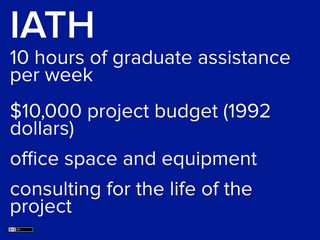
An overwhelming number of the initial IATH fellowships were awarded to full professors (all nine in the first two years) with the first two projects (Valley and Dante) being used as demonstrations to IBM of the viability of humanities driven research involving graduate students. And just as significantly, many of the fellowships arose from canonical questions within their disciplines: the causes and effect of the U.S. Civil War, the evolution of Walt Whitman’s work, the trajectory and complexity of William Blake’s work, etc. Such fellowships fixed novel, alternative and contingent digital activities to existing structures under the rubric of innovation or enhancement to existing scholarly activities.

Under such a model, faculty can be recruited as participants, supporters, and advocates and digital humanities initiatives and centers can demonstrate their effects on the local academic community—as service, if nothing else. For a new endeavor in the fundamentally conservative academy, the adoption of a pre-made structure of organizing labor, the "fellowship", was politically astute and laid much of the groundwork for the wide success of the field today. Fellows are advocates for the digital humanities and examples of its proliferation into humanities disciplines. These attractions—cultivating "star" faculty, advancing easily recognized "canonical" topics, and developing a constituency—still might suggest that the best move for newcomers to digital humanities is to adopt an old pattern of organizing work.
Most initiatives today that offer these types of opportunities do so using grant funding (e.g. from the Andrew W. Mellon Foundation or other funders) or using internal funds designed to be matched through external grants. Departments often struggle to recognize this type of fellowship where the department bears the burden of funding a replacement instructor rather than a grant or external fellowship providing those buyouts. Remembering our own caution against anecdote, we want to direct attention here not to the particularity of these details but to the ways in which the practice of digital humanities as "fellowships" was/is imbricated in the structures of the larger institutions.
At a broader level, this pattern of faculty fellowships—the subsidizing of the "work" of being a humanist—tends to only recognize a narrow construction of what being a humanist means and what is encompassed in humanities research.
That construction is often deeply conservative both in the sense of recognizing only the same hierarchies of status and privilege and being quantified in terms set by the prevailing values of the increasingly corporate university.

This is pernicious in itself but faculty fellowships ultimately also devalue other kinds of work—that produced by the rest of the economy that is required to create new knowledge. It is paramount to recognize here the ways in which the value of “work” has changed—the merits by which a project was considered complete have continued to shift away from experimentation and towards production. As digital humanities evolved, so too did the scale of work that individual fellows attempted during their fellowship period. Expectations both on behalf of the fellow in terms of what could be completed within the year as well as rising expectations of what constitutes good or interesting digital humanities scholarship creates both internal and external pressures that work against critical awareness of complicity within the neoliberal university.
Value of a “Deflationary” Approach
While the project of applying reflexive critique to labor has long been an avenue for humanistic analysis of a number of domains, in the context of digital humanities research such critique has been woefully underdeveloped. The digital humanities has committed itself to critique and exploration of existing structures in scholarly communication (e.g. new modes of publishing) as well as tenure and promotion yet has not extended this scepticism to more kinds of work practices. This seems a logical next step and one more relevant to consideration of participants not in tenure-track faculty roles.
In the version of his essay "Where is cultural criticism in the digital humanities?" published in the Debates in the Digital Humanities volume, Alan Liu focuses on the production and consumption of "the digital humanities" in terms of what he calls "the great post-industrial, neoliberal, corporate, and global flows of information-cum-capital." This commitment to examining the digital humanities from a world-system view does much to explain, if not excuse, the caricature of digital humanities work that follows. We would escape this rhetorical cycle by taking Liu’s question extremely literally.
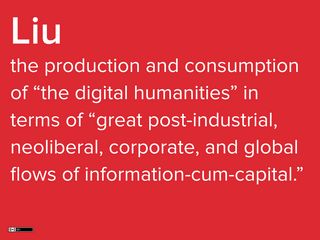
We argue that focusing precisely on the where of the digital humanities, that is on sets of material practices employed at a specific site during the production of digital humanities work re-opens stale questions to new analytical approaches and, much better, to new avenues of intervention. Indeed, to save the question of “Where is cultural criticism in the digital humanities?” from tendentiousness requires richer, more detailed accounts of the work of digital humanities in materialist terms to supplement Liu’s high-level cultural studies perspective. Such a “deflationary” approach helps us escape what Latour referred to as the “cognitive fallacy”—treating research as though it occurs chiefly or wholly in the mind rather than as a set of trajectories through material practices. We advance this somewhat Latourian perspective as only one way of improving the critical attention paid to labor in the digital humanities. There are of course additional lenses that could be usefully applied. For instance, we have not yet treated the “affective labor” that plays a vital role in DH work nor undertaken to analyze the ways in which "professionalization" deforms labor and labor advocacy.
The subjects of our examination need not be radically different. We should discuss many of the same things we’ve discussed in the past—funding, staffing, space, tools, etc.—not as anecdotes or best practices but as effects of larger structural dynamics that we should regard critically.
Drawing attention to labor, to work, and to the materialist realities of both, allows us to underline more and different segments of the trajectories of what constitutes digital humanities (borrowing again from our keynote speaker). We believe this is an additional avenue of critique that should be explored alongside analyses like Liu’s or Matthew Kirschenbaum’s that treat “the digital humanities” chiefly as a symbols or discourses in an agonistic world system. This presentation is a first effort to call out the need for approaches that neither cultural studies nor digital humanities usually provide and should serve as a provocation to our wider community to explore where digital humanities work takes place, especially that which is undertaken by other workers within the larger academic system of labor.